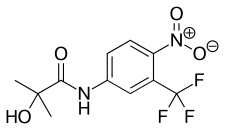Hydroxyflutamide
 | |
 | |
| Clinical data | |
|---|---|
| Synonyms | 2-Hydroxyflutamide; HF; OHF; Flutamide-hydroxide; SCH-16423; Hydroxyniphtholide; Hydroxyniftolide; α,α,α-Trifluoro-2-methyl-4'-nitro-m-lactotoluidide |
| Drug class | Nonsteroidal antiandrogen |
| Identifiers | |
| |
| CAS Number | |
| PubChem CID | |
| IUPHAR/BPS | |
| ChemSpider | |
| UNII | |
| KEGG | |
| ChEBI | |
| ChEMBL | |
| ECHA InfoCard |
100.169.708 |
| Chemical and physical data | |
| Formula | C11H11F3N2O4 |
| Molar mass | 292.21125 g/mol |
| 3D model (JSmol) | |
| |
| |
Hydroxyflutamide (HF, OHF) (developmental code name SCH-16423), or 2-hydroxyflutamide, is a nonsteroidal antiandrogen (NSAA) and the major active metabolite of flutamide, which is considered to be a prodrug of hydroxyflutamide as the active form.[1][2] It has been reported to possess an IC50 of 700 nM for the androgen receptor (AR), which is about 4-fold less than that of bicalutamide.[3]
| Compound | RBA (%) |
|---|---|
| Metribolone | 100 |
| Dihydrotestosterone | 85 |
| Cyproterone acetate | 7.8 |
| Bicalutamide | 1.4 |
| Nilutamide | 0.9 |
| Hydroxyflutamide | 0.57 |
| Flutamide | <0.0057 |
References
- ↑ Serra, C; Sandor, NL; Jang, H; Lee, D; Toraldo, G; Guarneri, T; Wong, S; Zhang, A; Guo, W; Jasuja, R; Bhasin, S (2013). "The effects of testosterone deprivation and supplementation on proteasomal and autophagy activity in the skeletal muscle of the male mouse: Differential effects on high-androgen responder and low-androgen responder muscle groups". Endocrinology. 154 (12): 4594–606. doi:10.1210/en.2013-1004. PMC 3836062. PMID 24105483.
- ↑ Singh, Shankar; Gauthier, Sylvain; Labrie, Fernand (2000). "Androgen Receptor Antagonists (Antiandrogens) Structure-Activity Relationships". Current Medicinal Chemistry. 7 (2): 211–247. doi:10.2174/0929867003375371. ISSN 0929-8673. PMID 10637363.
- ↑ Furr BJ (1995). "Casodex: preclinical studies and controversies". Annals of the New York Academy of Sciences. 761: 79–96. doi:10.1111/j.1749-6632.1995.tb31371.x. PMID 7625752.
- ↑ Ayub M, Levell MJ (August 1989). "The effect of ketoconazole related imidazole drugs and antiandrogens on [3H] R 1881 binding to the prostatic androgen receptor and [3H]5 alpha-dihydrotestosterone and [3H]cortisol binding to plasma proteins". J. Steroid Biochem. 33 (2): 251–5. doi:10.1016/0022-4731(89)90301-4. PMID 2788775.
This article is issued from
Wikipedia.
The text is licensed under Creative Commons - Attribution - Sharealike.
Additional terms may apply for the media files.